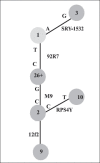Y-haplotypes and idiopathic male infertility in an Indian population
- PMID: 20407645
- PMCID: PMC2846564
- DOI: 10.4103/0971-6866.50865
Y-haplotypes and idiopathic male infertility in an Indian population
Abstract
Infertility being a multifactorial disorder, both genetic and environmental factors contribute to the etiology of infertile phenotype. Chromosomal anomalies and Y-microdeletion are the established genetic risk factors of male infertility. Y-haplotypes has been found as risk factor for male infertility in certain populations, though in certain others no association has been reported, suggesting a population-specific association of these variations with male infertility. In a case-control study, 165 azoo-/oligospermic patients and 200 controls were haplotyped for certain Y-haplogroups for a possible association with idiopathic male infertility in an Indian population. Analysed Y-haplogroups showed no association with infertile phenotype. Thus this genetic factor is not a risk for infertility in the studied Indian population but that does not rule out the possibility of any of them, to be a risk in other populations.
Keywords: Male infertility; Y-haplotypes; single nucleotide polymorphism.
Conflict of interest statement
Figures




Similar articles
-
Associations between male infertility and ancestry in South Americans: a case control study.BMC Med Genet. 2017 Jul 26;18(1):78. doi: 10.1186/s12881-017-0438-z. BMC Med Genet. 2017. PMID: 28747152 Free PMC article.
-
A386G polymorphism of the DAZL gene is not associated with idiopathic male infertility in North India.J Hum Reprod Sci. 2009 Jul;2(2):54-6. doi: 10.4103/0974-1208.57222. J Hum Reprod Sci. 2009. PMID: 19881148 Free PMC article.
-
Lack of association between Y chromosome haplogroups and male infertility in Japanese men.Am J Med Genet A. 2003 Jan 15;116A(2):152-8. doi: 10.1002/ajmg.a.10827. Am J Med Genet A. 2003. PMID: 12494434
-
[Male infertility and microdeletions of the Y chromosome].Gynecol Obstet Fertil. 2002 May;30(5):405-12. doi: 10.1016/s1297-9589(02)00340-5. Gynecol Obstet Fertil. 2002. PMID: 12087936 Review. French.
-
AZF deletions and Y chromosomal haplogroups: history and update based on sequence.Hum Reprod Update. 2005 Jul-Aug;11(4):319-36. doi: 10.1093/humupd/dmi017. Epub 2005 May 12. Hum Reprod Update. 2005. PMID: 15890785 Review.
Cited by
-
Spermatogenic failure and the Y chromosome.Hum Genet. 2017 May;136(5):637-655. doi: 10.1007/s00439-017-1793-8. Epub 2017 Apr 29. Hum Genet. 2017. PMID: 28456834 Review.
References
-
- Krausz C, Quintana-Murci L, Rajpert-De Meyts E, Jorgensen N, Jobling MA, Rosser ZH, et al. Identification of a Y chromosome haplogroup associated with reduced sperm counts. Hum Mol Genet. 2001;10:1873–7. - PubMed
-
- Matzuk MM, Lamb DJ. Genetic dissection of mammalian fertility pathway. Nat Cell Biol Nat Med. 2002 Oct;4(Suppl):s41–9. - PubMed
-
- Johnson MD. Genetic risks of intracytoplasmic sperm injection in the treatment of male infertility: Recommendations for genetic counseling and screening. Fertil Steril. 1998;70:119–24. - PubMed
-
- McElreavey K, Krausz C, Bishop CE. The human Y-chromosome and male infertility. Results Probl Cell Differ. 2000;28:211–32. - PubMed
-
- Jobling MA, Tyler-Smith C. The human Y chromosome: An evolutionary marker comes of age. Nat Rev Genet. 2003;4:598–611. - PubMed
LinkOut - more resources
Full Text Sources

